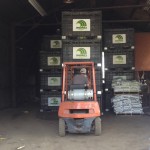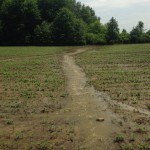Throughout the summer, one of my tasks I described in the introduction post was meeting with growers throughout the sales district held by my DSM (District Sales Manager). Being in sales, the need for connection is the basis of a successful sale. In order to make the sale, you need to create a relationship with your customer to build trust and reliability, as well as a sense of loyalty to gain a returning client base. While all of these aspects are essential, no two of my visits have been the same. Each looks for different ways to make those connections, each customer looks for a different kind of advice, and a different level of attention to their product portfolio and operation. For the purpose of this post, I’d like to walk you through a typical day of making a couple farm visits to some well-established customers.
Usually, all of my days begin by meeting up with my DSM in order to go over the plan for the day. Some days I’m scouting, some days I’m making seed deliveries (which is wrapping up now that planting is just about over), and today, we will be making a few calls on growers. I follow him in my truck for the hour trip west into Pennsylvania, multi-tasking by joining on one of the intern class bi-weekly conference call sessions held by our team lead to check up on our progress. As we arrive to the farm, the grower is out in his shop working on some equipment. My DSM and I enter the building, saying hello and asking how his family is. Knowing his personality, this family is very family-oriented and this is a great way to open up conversation for the rest of the morning. From there, we start to discuss what we saw in the fields on our last visit, especially now that heavy rains have really affected the crop. After about an hour casual evaluation and commentary, the three of us jump into the truck to begin a bit of a farm tour.
Getting to the first field, we see that the incredible amount of rain have washed gullies into the ground and washed away some spots, which is not uncommon for the hilly ground. The growers notices that with his recent planting, the beans were very young and some of them “washed,” or were removed from the location where they were planted, leaving “skips” in the row. He made a comment to my DSM that he might just cultivate the beans back into the soil with a field cultivator and replant. Before telling him to go ahead with the decision and enacting the seed replant policy the Channel company offers, my DSM offers to give the field a brief look-over. After I grabbed the trusty field from the truck, we walked throughout the field and counted the number of missing plants in comparison to the 1/10 of an acre measurement in comparison to the intended planting population. We repeated this a few times, then came to the conclusion that it would not be necessary to replant, as the loss was not too great and the existing bean plants would compensate for the amount of space.
While this was the recommendation given by my DSM and I, we are still here to listen to the customer. Our grower decided that he would not replant, but if so, we would be ready to deliver him new seed when ready. The goal is to maintain the customer, and maintain the sale, hence through meeting the grower’s needs. Getting back into the truck, we visited a few more fields to do some “stand counts” (seeing how many plants emerged as a measure of weather conditions and seed quality) to check on the success of planting post-weather.
As any customer visits goes, it wouldn’t be complete unless we took the grower for lunch. While this may seem over-the-top to some, it not only shows a friendly gesture to the farmer indicating that we are glad to have their business, it also provides another good opportunity to sit down in a casual setting to discuss their ideas and perceptions of the products and what they would like to see. This is very important, as it gives my DSM and I an idea of how to better manage their account and to understand how we can incorporate ourselves into their production goals. Wrapping up lunch, we thanked him for his time and the chance to walk some fields with him as a grower’s time is very valuable. Next, it was time to drive to our second visit.
The second grower doesn’t have as long of a relationship or one that is as well-built as the grower we just visited, as the first one has been doing business with my DSM for years. This farmer is older, yet new to the company after a disagreement with the salesman of his old brand. This means that this customer and account has to be dealt with more carefully (not to say that we do not deal with accounts with equal care, this one just must be treated with a greater sense of professionalism rather than a sense of friendship). I have not met this farmer before, and as soon as I arrive I pleasantly introduce myself as an intern of the company in order to clear any questions about my presence on his operation. My DSM and I do similar activities as the first, asking questions about the status of his fields and his feelings about this year’s seed varieties, as well as visit a few fields. The grower is hesitant about some of the seed choices he’s picked out for the year, but my DSM knows the product line up inside out and can help explain the features of each variety and how it will benefit his production model. Hopefully by the end of the summer, I will also be able to know the products on a level where I feel comfortable making recommendations to the farmers.
As the visit comes to an end, we take a couple empty seed boxes back with us in the beds of our trucks. These big black boxes hold 50 units of corn seed (one unit of corn seed is 80,000 seeds, so that’s four million seeds, and at 52 lbs. a unit, that’s 2,600 lbs. of corn not counting the weight of the heavy plastic box itself) and are used to ship large quantities of seeds to growers as opposed to the bagged seed, which one bag equals one unit of seed. After the trek back to the main warehouse, one of the sub-dealers jumps on the forklift and stacks the boxes up, which they will eventually be loaded onto a semi truck and hauled back to the seed packing facilities to be reused.
While I said no two grower visits are the same, they are all equally enjoyable getting to know the farmers, as well as building up my own relationships to practice the skill of maintain the sale through loyalty and interest in the customer. I have a feeling this will come in handy throughout my career, no matter where I go.



